Xu Bing: Tobacco Project
Virginia Museum of Fine Arts
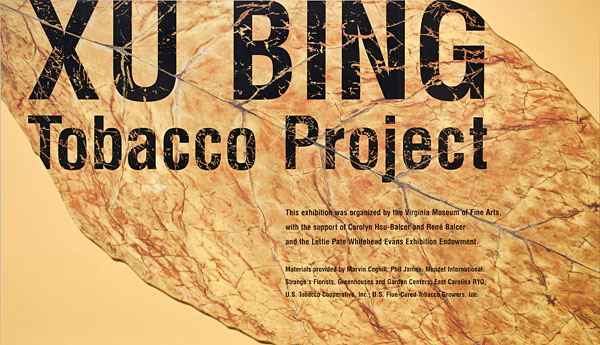 |
Xu Bing: Tobacco Project explores the production and culture of tobacco as seen through the eyes of one of China’s most innovative contemporary artists. The exhibition combines important pieces from the artist’s earlier projects at Duke University in North Carolina and the Shanghai Gallery of Art in China with new work inspired by visits to tobacco farms, warehouses, and cigarette factories in Virginia. Altogether, the exhibition spans a dozen years of Xu Bing’s work and surveys one of his most ambitious undertakings.
Background on the Artist
Xu Bing is considered one of the most important Chinese artists of his generation. Born in 1955, he lived through a tumultuous period in China’s history. After being sent to the countryside as a teen during the Cultural Revolution, he returned to Beijing to study and then teach printmaking at the Central Academy of Fine Arts during successive waves of tightening and loosening government control over the arts. A central and controversial figure in the Chinese New Wave Movement, he moved to the United States in 1990 shortly after the Tiananmen uprising.
In 1999 Xu Bing was awarded a MacArthur Fellowship in recognition of his contributions, particularly in printmaking and calligraphy. A number of awards followed, including the Fukuoka Asian Culture Prize in 2003, the Wales International Visual Art Prize “Artes Mundi” in 2004, and the Southern Graphics Council Lifetime Achievement Award in 2006. Xu Bing was appointed vice president of the Central Academy of Fine Arts, one of the most important positions in the Chinese art system, in 2008.
A prolific and versatile artist, Xu Bing has created a range of works that explore traditional and experimental bookmaking and printmaking (best exemplified by his iconic installation Book from the Sky) and language (including his invention of Square Word Calligraphy and the ongoing Book from the Ground), as well as animals and nature.
Xu Bing has had solo exhibitions at the Arthur M. Sackler Gallery, Washington, D.C.; the New Museum of Contemporary Art, New York; the Joan Miro Foundation, Barcelona; and the National Gallery in Prague. He has also shown his work at many major international group exhibitions including the 45th and 51st Venice Biennales, the Biennale of Sydney, and the Johannesburg Biennale. Over the years, his work has appeared in high school and college textbooks around the world including Abrams’ Art Past Art Present, Gardner’s Art through the Ages, and Craig Clunas’s Art in China, which is part of the Oxford History of Art series.
Virginia Tobacco Project, 2011
Xu Bing uses tobacco—as a material and a subject—to explore a wide range of issues, from global trade and exploitation to the ironies of advertising a harmful substance. As a print and bookmaker, he is especially fascinated by the visual culture of packaging and marketing tobacco. When Duke University invited Xu Bing to be the artist-in-residence in 2000, he was drawn into the history of the Duke family, which led to his first Tobacco Project. He followed that with a second Tobacco Project in Shanghai in 2004. He sees the Virginia Tobacco Project as the third in a trilogy.
Xu Bing’s interest in “tobacco culture” extends to the historical impact of China’s large-scale exportation of tobacco products from the United States beginning in the late 19th century. For the Durham exhibition, he made a gigantic book of tobacco leaves that was gradually devoured by beetles during the course of the exhibition. For Traveling Down the River, he laid a thirty-foot-long cigarette over a reproduction of a hand-scroll of the celebrated classical Chinese painting Along the River during the Qingming Festival. As the cigarette burned, it left scorch marks on the image, inscribing time as a serpentine scar and the journey as a residue of ash. An installation created in an abandoned tobacco plant near Duke included a recorded voice reading the medical records of Xu Bing's father, who died of lung cancer, conveying a personal connection to tobacco and death. In exploring the complex connections between people and tobacco, the project ultimately concerns fundamental issues of human culture and of tobacco as a medium of social exchange.
The VMFA exhibition consists of selected works from these prior exhibitions combined with new works inspired by the time Xu Bing spent in Virginia. His several visits between 2007 and 2010 to the Commonwealth included a tour of the Philip Morris manufacturing center in Richmond—one of the largest cigarette production facilities in the world—and trips to the Southside region of Virginia to see an historic tobacco warehouse and several family-owned tobacco farms. He also did research at the Virginia Historical Society and the Valentine Richmond History Center.
In February 2011, Xu Bing returned for a two-week residency in Richmond, during which time he worked on several large pieces, some entirely new and some recreations of past pieces that no longer exist or cannot travel. The new pieces include a 440-pound solid block of compressed tobacco embossed with the text “light as smoke”; a book of fifty-three historic tobacco stencils printed on sheets of cigarette paper to form a bound volume of free-verse blues poetry; wooden boxes stamped with the logo “Puff Choice” and made to hold double cigarettes: two cigarettes joined to a double-length filter. Refabrications of earlier pieces include a colossal book made of flattened whole tobacco leaves, resembling the Duke book described above, but with new text describing the early years of the Jamestown, Virginia settlement and the important role of tobacco; a recreation of Traveling Down the River, including a forty-one-foot long version of the scroll and an equally long cigarette that was burned partly down its length; and a large arrangement of dried branches called Match Flower, with each of the hundreds of tips coated in red match-head material.
Working with former graduate students from Virginia Commonwealth University’s School of the Arts, Xu Bing also created the template for a large installation piece that forms the climax of the exhibition: a tiger-skin rug made from approximately half a million cigarettes standing on end, with either filter or tip up to make an alternating pattern of orange and white.
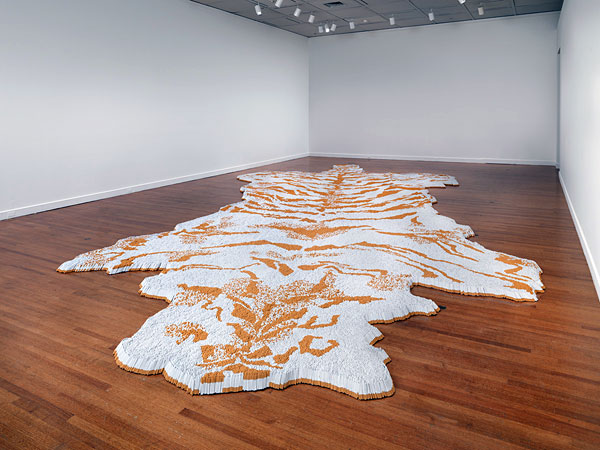 |
|
|
The tiger-skin rug, which 1st Class mimics, is a potent symbol of human prowess: it confirms our superiority by transforming one of nature’s fiercest predators into a lifeless skin beneath our feet. Tiger hunting, long a royal and aristocratic sport across South, Central, and East Asia, was also favored by colonizers from the West, whose increased firepower caused greater loss to their prey. Xu Bing’s piece exploits these associations with luxury, status, and domination. The beauty of the tiger-skin pattern, its allusions to the dangerous thrill of the hunt, and the uncanny allure of the massive display of cigarettes ironically glamorize the addictive pull and risks of smoking.
The Shanghai version of this piece (2004) was called Honor and Splendor and formed with 660,000 “Wealth” cigarettes, one of the cheapest brands in China. Likewise, the 500,000 “1st Class” cigarettes in the Virginia version are an American discount brand. During a Richmond residency in February 2011, Xu Bing created a template for the piece so that fabrication could continue after he left. After making a full-scale drawing on brown craft paper, he used a grid to transfer it to squares of carpet. A team of assistants then glued the cigarettes onto the squares and assembled them into a whole.
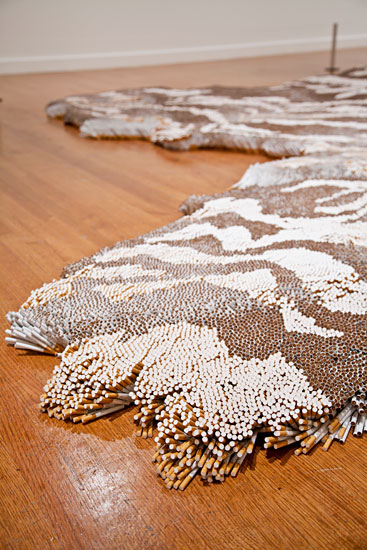
|
~
Backbone, a printed book (also displayed as a full set of individually framed pages) was made using nineteenth-century tobacco stencils from the Valentine Richmond History Center, their designs and colors somewhat adjusted and printed on sheets of cigarette paper.
| Backbone, 2011 (bound book cover detail, bound book, and select framed page detail) Collaboration with René Balcer Offset printing on cigarette paper with screen-printed cover Fabrication assisted by Sayaka Suzuki and Xu Bing’s Beijing Studio Images courtesy of Valentine Richmond History Center; paper courtesy of Phil James, Mundet International |
Xu Bing invited his friend René Balcer (writer for the television show Law & Order) to collaborate with him on the project. Configuring fifty-three stencils from hundreds of options—some repeated but with no other words added—Balcer created a free-verse blues poem that he describes as an homage to the African American women who labored in the tobacco industry.
See also a scrollable image of all framed pages and hear a recording of the poem, performed by Captain Luke (vocals) and Big Ron Hunter (guitar).
~
Xu Bing’s first Tobacco Book (2000) included passages about the Duke family’s tobacco dealings, which appeared in Sherman Cochran’s Big Business in China. For the Shanghai version (2004), Xu Bing used an excerpt from the Chinese translation of Cochran’s book. The Virginia version—like the others, made from whole tobacco leaves flattened and glued together—is printed with text from a historical account of the first years of Jamestown in the early seventeenth century. Xu Bing chose the text because it connects several of his interests: the contribution of John Rolfe to the survival of the early American colony and the development of a Virginia tobacco brand; the value of tobacco as a commodity, which is compared to silk and silkworms (which Xu Bing has also used in his work); and the cross-cultural encounter with Pocahontas.
~
At the Valentine Richmond History Center, Xu Bing came across a historical advertisement in which a tobacco company proclaimed its product to be “light as smoke.” Xu Bing’s piece highlights the contrast between the materiality of tobacco and its evanescence when consumed. The 440-pound block is unchanged from its form on arrival at a cigarette manufacturing center, with the exception of the raised letters. It also makes reference to minimalist sculpture of the 1960s and 1970s and to a type of fermented Chinese tea called pu-erh, also sold in compressed blocks.
|
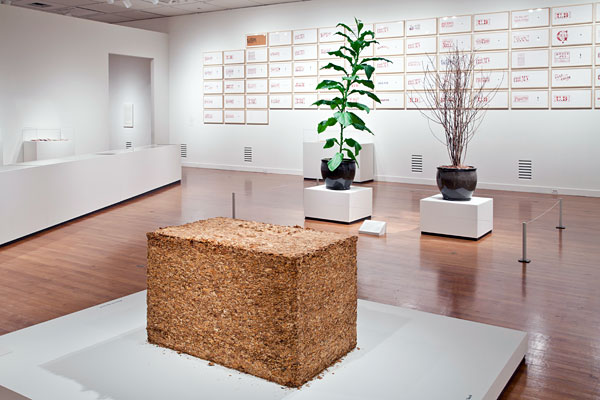 |
| Light as Smoke, 2011 Block of compressed tobacco with raised text Tobacco leaf courtesy of Marvin Coghill; fabrication assisted by Michael Muelhaupt |
~
Match Flower presents a new version of a work first made in Shanghai in 2004. The piece appears as both a delicate flowering bush and an image of combustibility. Here, it is paired with Nature’s Contribution, creating a stark contrast between its brittle artificiality and the supple, verdant qualities of the live tobacco. From the time of his first visits to North Carolina farms in 1999, Xu Bing hoped to display live plants as part of Tobacco Project. This marks the first realization of that goal, allowing the exhibition to incorporate tobacco’s full cycle from live plant to cured leaf, packaged product, and, finally, ash.
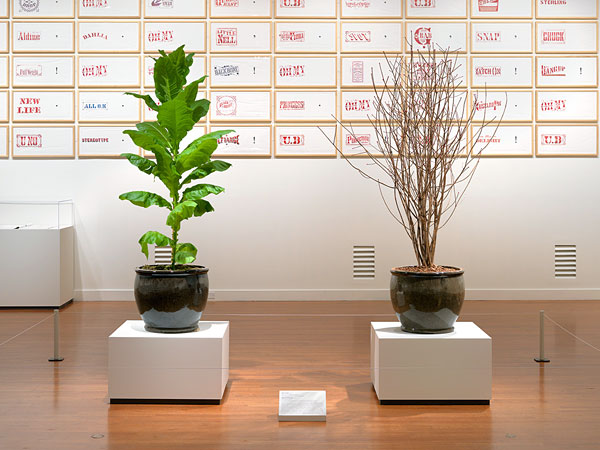 |
|
| Nature’s Contribution, 2011 Live tobacco plant Courtesy of Strange’s Florists, Greenhouses and Garden Centers |
Match Flower, 2011 Branches, red match-head paste Fabrication assisted by Andrea Donnelly |
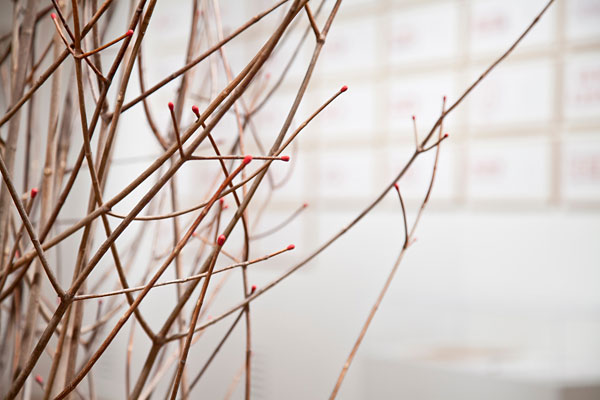 |
|
| Match Flower, 2011 (detail) Branches, red match-head paste Fabrication assisted by Andrea Donnelly |
|
Xu Bing: Tobacco Project is organized by the Virginia Museum of Fine Arts and curated by John B. Ravenal, Sydney and Frances Lewis Family Curator of Modern and Contemporary Art. The exhibition travels to the Aldrich Contemporary Art Museum, Ridgefield, Connecticut, opening on January 29, 2012.
A scholarly catalogue accompanies the exhibition, providing a comprehensive overview of Xu Bing’s tobacco projects. The catalogue, published by the Virginia Museum of Fine Arts, includes several essays along with reproductions of all the tobacco works. ![]()